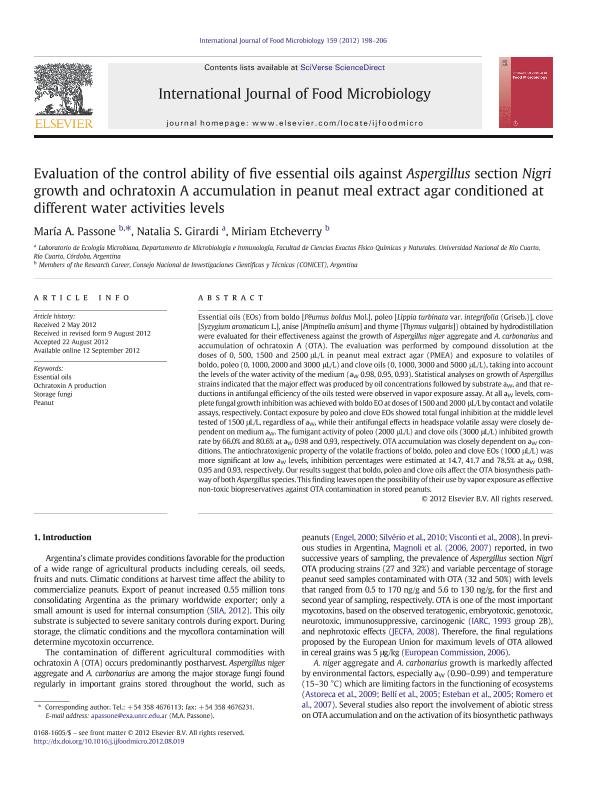Artículo
Evaluation of the control ability of five essential oils against Aspergillus section Nigri growth and ochratoxin A accumulation in peanut meal extract agar conditioned at different water activities levels
Fecha de publicación:
10/2012
Editorial:
Elsevier Science
Revista:
International Journal of Food Microbiology
ISSN:
0168-1605
Idioma:
Inglés
Tipo de recurso:
Artículo publicado
Clasificación temática:
Resumen
Essential oils (EOs) from boldo [Pëumus boldus Mol.], poleo [Lippia turbinata var. integrifolia (Griseb.)], clove [Syzygium aromaticum L.], anise [Pimpinella anisum] and thyme [Thymus vulgaris]) obtained by hydrodistillation were evaluated for their effectiveness against the growth of Aspergillus niger aggregate and A. carbonarius and accumulation of ochratoxin A (OTA). The evaluation was performed by compound dissolution at the doses of 0, 500, 1500 and 2500 μL/L in peanut meal extract agar (PMEA) and exposure to volatiles of boldo, poleo (0, 1000, 2000 and 3000 μL/L) and clove oils (0, 1000, 3000 and 5000 μL/L), taking into account the levels of the water activity of the medium (aW 0.98, 0.95, 0.93). Statistical analyses on growth of Aspergillus strains indicated that themajor effect was produced by oil concentrations followed by substrate aW, and that reductions in antifungal efficiency of the oils tested were observed in vapor exposure assay. At all aW levels, complete fungal growth inhibitionwas achievedwith boldo EOat doses of 1500 and 2000 μL/L by contact and volatile assays, respectively. Contact exposure by poleo and clove EOs showed total fungal inhibition at the middle level tested of 1500 μL/L, regardless of aW, while their antifungal effects in headspace volatile assay were closely dependent on medium aW. The fumigant activity of poleo (2000 μL/L) and clove oils (3000 μL/L) inhibited growth rate by 66.0% and 80.6% at aW 0.98 and 0.93, respectively. OTA accumulation was closely dependent on aW conditions. The antiochratoxigenic property of the volatile fractions of boldo, poleo and clove EOs (1000 μL/L) was more significant at low aW levels, inhibition percentages were estimated at 14.7, 41.7 and 78.5% at aW 0.98, 0.95 and 0.93, respectively. Our results suggest that boldo, poleo and clove oils affect the OTA biosynthesis pathway of both Aspergillus species. This finding leaves open the possibility of their use by vapor exposure as effective non-toxic biopreservatives against OTA contamination in stored peanuts.
Palabras clave:
ESSENTIAL OILS
,
OCHRATOXIN A PRODUCTION
,
PEANUT
,
STORAGE FUNGI
Archivos asociados
Licencia
Identificadores
Colecciones
Articulos(CCT - CORDOBA)
Articulos de CTRO.CIENTIFICO TECNOL.CONICET - CORDOBA
Articulos de CTRO.CIENTIFICO TECNOL.CONICET - CORDOBA
Citación
Passone, Maria Alejandra; Girardi, Natalia Soledad; Etcheverry, Miriam Graciela; Evaluation of the control ability of five essential oils against Aspergillus section Nigri growth and ochratoxin A accumulation in peanut meal extract agar conditioned at different water activities levels; Elsevier Science; International Journal of Food Microbiology; 159; 3; 10-2012; 198-206
Compartir
Altmétricas




